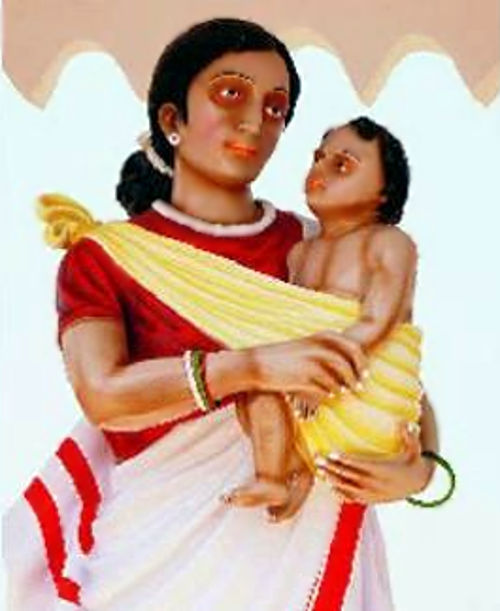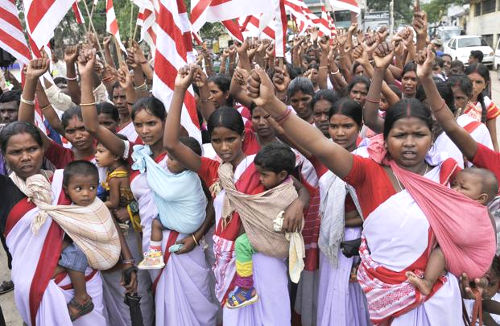
The Church has always made adaptations in its presentation to local cultures around the world. The Catholic Church is the one, universal Church for all people. Elements of local customs and traditions are often incorporated in buildings, liturgy, celebrations and so on. This is done not in accommodation of incompatible beliefs (which the Church always rejects), but to make the visible presence of the Church less distant or foreign.
One common example of this is in paintings and statuary depicting our Lord and His Blessed Mother. They are shown as every race and dressed consistent with virtually every culture. This is not an effort to deceive, but one of lowering barriers and opening hearts.
In Singhpur, capital of the eastern Indian state of Jharkhand for example, Mary and baby Jesus are shown with bodies and dress consistent with the local indigenous people. They are dark complexioned and wear traditional tribal clothing. For Mary, that is a white sari with red trim over a red blouse with a necklace and earings.

This statue was unveiled in late May by Cardinal Telesphor Toppo at the local parish.
Interestingly, unusually, oddly even — this image has angered a segment of the local Hindu population. Angered to the point of protests on the order of 15,000 to 20,000 people in late August. The police had to erect barricades around the church to protect it. The crowds brought a replacement statue, dressed in a foreign way, that they felt would be less “confusing.”

To these protesters, the issue was exactly that the statue represented Mary as a local and not a foreigner. They felt that this was intentional deception to “confuse” the population and make them receptive to Christianity.
The International Business Times quotes opposing local opinion:
“Showing Mother Mary as a tribal is a part of the larger design to make the tribal population believe that she was from their community and confuse them,” Tigga added. “One hundred years from now, people here would start believing that Mother Mary was actually our tribal goddess. It’s an attempt to convert Sarna tribals to Christianity. If they do not remove it, a nationwide protest will be organized.” Tigga told the Times of India that “Mother Mary was a foreigner and showing her as a tribal woman is definitely not correct.”
In response, Christian tribals have defended the statue. “What’s wrong in this? It’s just like the Chinese, Japanese, Irish, German or even the African version of Mother Mary and Baby Jesus,” said Father Augustine Kerketta, a senior church official in Ranchi. “It happens everywhere as part of enculturation of the local tradition.” Kerketta also said some local politicians are likely behind the protests to foster religious enmity. “General elections are due early next year, and some people may wish to divide the Christian and non-Christian tribal populations for political gains,” he said.
In a broader context, the conversion of Indians – whether they be tribals or others – has long been a sore point with Hindus who view the work of missionaries as a form of intervention by foreign forces to degrade and/or diminish Indian culture. Indeed, some Hindu organizations have praised Tigga’s efforts. The Haindava Keralam, a Hindu advocacy group based in the southwestern state of Kerala, commented that, by draping Mother Mary in the clothes of Indian tribals, Christian missionaries are creating “distortions” by masquerading “foreign religions” as “local religions by appropriating (more correctly, stealing) their way of worship and religious symbols.”
Haindava noted that the sari is a “Hindu dress worn by Hindu women. The white sari with a red border is used by women of the Sarna community on auspicious occasion[s],” adding that Christian missionaries are attempting similar practices in Kerala. “Should we permit such degradation of our religion?” Haindava asked rhetorically. “These are the [same] people who derided our religion, culture, rituals as mythology and superstition, why are they [seeking to] to imitate it?”
A commenter on the Haindava website named S. Manoharan thundered that: “All Hindus should understand that conversion to foreign religions and praying to foreigners does not give any spiritual satisfaction.” Another commenter named Ravi Nair opined that Evangelical Christians have been using deceptive conversion techniques in Latin America, Africa and in India for centuries. “The after-effects of coercive and deceptive religious conversion [are] disastrous,” he wrote. “Although coercive religious conversion of Hindus has deep historical roots, recent deceptive and cunning strategy poses serious political, social and psychological problems. In this era of globalization, evangelists with unlimited funds use sophisticated, deceptive, psychological mind manipulation techniques to lure, brainwash, and convert innocent people, Once they are converted, they are abandoned for rot. In India, the Vatican and evangelical groups use them as political pawn.”
Nair added that the sudden appearance of a sari-draped Mother Mary is a “manipulation technique.” “These missionaries are criminals with big ego,” he indicated. “They should be detained, arrested, and a force continuum shall be applied until they leave India with their trick. These conversion thief act without fear, shame, guilt, or remorse for a bowl of chicken soup from their alien slave masters. They should be stopped to save India.”
There is a lot going on here: nationalism, religious intolerance and community organizers whipping-up a crowd for their own political ends.
The above quote is from Virgin Mary In A Sari: Hindus Outraged By Christian Statue Depicting Blessed Mother And Jesus In Indian Tribal Dress.
The BBC also covers this. For a Hindu perspective, see this post.



























But to what shall I compare this generation? It is like children sitting in the marketplaces and calling to their playmates, “‘We played the flute for you, and you did not dance; we sang a dirge, and you did not mourn.’ For John came neither eating nor drinking, and they say, ‘He has a demon.’ The Son of Man came eating and drinking, and they say, ‘Look at him! A glutton and a drunkard, a friend of tax collectors and sinners!’ Yet wisdom is justified by her deeds.
Or, as my mother would say, “There’s just no pleasing you!”